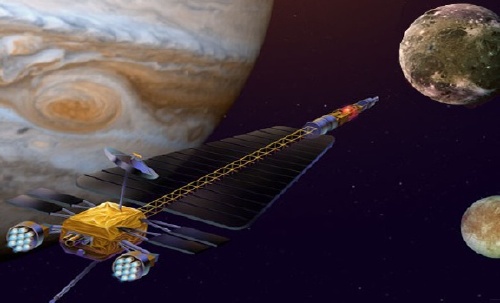 |
|||||
|---|---|---|---|---|---|
| EXPLORING THE JUPITER SYSTEM | |||||
| Jupiter | Moons | Oceans | Volcanos | Rings | Radio |
| JIMO | Galileo | Cassini | Pioneer | Voyager | Resources |
Jupiter has a Ring of Dust
MOONS OF THE SOLAR SYSTEM »
A detector aboard the Galileo spacecraft when it was orbiting Jupiter in 1998 turned up evidence of a faint ring of dust in a backward orbit around the giant planet, according to NASA's Jet Propulsion Laboratory (JPL) at Pasadena, California.
The 700,000-mi.-diameter doughnut of interplanetary and interstellar dust is looping around the giant planet in a "retrograde" orbit. That means it's moving in the opposite direction of the rotating planet and its moons.
Galileo was launched from Cape Canaveral in 1989 and explored Jupiter and its moons from 1995-2003.
Astronomers pointed out that an uneven dust ring was discovered around Jupiter by Voyager-2 back in 1979. They said that ring may have been created by collisions of small moonlets with micrometeoroids in the Jovian system.
While the Galileo ring is composed of tiny particles the size of smoke, it is much larger and more sparse than the ring found by Voyager. Astronomers suggest the Galileo ring may have originated beyond the Jovian system.
Now astronomers NASA's Cassini spacecraft will turn up something similar circling the planet Saturn. Cassini arrived at Saturn in 2004. Latest news from Cassini »
Solar System Search STO STO cover Questions Feedback Suggestions © 2004 Space Today Online